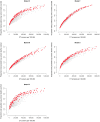Comparing benefits from many possible computed tomography lung cancer screening programs: extrapolating from the National Lung Screening Trial using comparative modeling
- PMID: 24979231
- PMCID: PMC4076275
- DOI: 10.1371/journal.pone.0099978
Comparing benefits from many possible computed tomography lung cancer screening programs: extrapolating from the National Lung Screening Trial using comparative modeling
Abstract
Background: The National Lung Screening Trial (NLST) demonstrated that in current and former smokers aged 55 to 74 years, with at least 30 pack-years of cigarette smoking history and who had quit smoking no more than 15 years ago, 3 annual computed tomography (CT) screens reduced lung cancer-specific mortality by 20% relative to 3 annual chest X-ray screens. We compared the benefits achievable with 576 lung cancer screening programs that varied CT screen number and frequency, ages of screening, and eligibility based on smoking.
Methods and findings: We used five independent microsimulation models with lung cancer natural history parameters previously calibrated to the NLST to simulate life histories of the US cohort born in 1950 under all 576 programs. 'Efficient' (within model) programs prevented the greatest number of lung cancer deaths, compared to no screening, for a given number of CT screens. Among 120 'consensus efficient' (identified as efficient across models) programs, the average starting age was 55 years, the stopping age was 80 or 85 years, the average minimum pack-years was 27, and the maximum years since quitting was 20. Among consensus efficient programs, 11% to 40% of the cohort was screened, and 153 to 846 lung cancer deaths were averted per 100,000 people. In all models, annual screening based on age and smoking eligibility in NLST was not efficient; continuing screening to age 80 or 85 years was more efficient.
Conclusions: Consensus results from five models identified a set of efficient screening programs that include annual CT lung cancer screening using criteria like NLST eligibility but extended to older ages. Guidelines for screening should also consider harms of screening and individual patient characteristics.
Conflict of interest statement
Figures



References
-
- National Lung Screening Trial Research Team (2011) Reduced Lung-Cancer Mortality with CT Screening. The New England Journal of Medicine 365: 2035–2038. - PubMed
-
- Pinsky PF (2013) Subset and Histological Analysis of Screening Efficacy in NLST. National Cancer Advisory Board. Bethesda, MD: Department of Health and Human Services.
-
- Jacobson FL, Austin JH, Field JK, Jett JR, Keshavjee S, et al. (2012) Development of The American Association for Thoracic Surgery guidelines for low-dose computed tomography scans to screen for lung cancer in North America: Recommendations of The American Association for Thoracic Surgery Task Force for Lung Cancer Screening and Surveillance. J Thorac Cardiovasc Surg 144: 25–32. - PubMed
Publication types
MeSH terms
Grants and funding
LinkOut - more resources
Full Text Sources
Other Literature Sources
Medical

